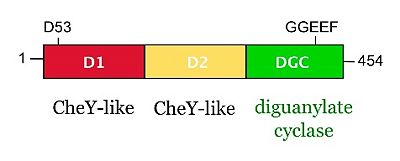PleD catalysis
From Proteopedia
Overviewfrom Caulobacter crescentus is a response regulator with an unorthodox catalytic, diguanylate cyclase, output domain. It is composed of a canonical CheY-like response regulator receiver (, also called D1) domain, a Rec-like (, also called D2) adaptor domain, and a C-terminal domain that confers the catalytic acitvity.
Substrate bindingThe motif is part of the as identified in the structure of PleD in complex with . The GGDEF domain binds only one GTP substrate molecule. For the reaction to proceed, two GTP loaded GGDEF domains have to align antiparallely.
Complete active site(The following model of the competent dimer is theoretical.)
After binding of the (here we show GMP, please update), it is believed that two GGDEF domains associate antiparallely to form a catalytically competent dimer (, ). Then, by inter-molecular nucleophilic in-line attack of the O3' atom onto the α-phosphorous of the other GTP substrate molecule, two phosphodiester bonds are formed under release of two pyrophosphate molecules (2 GTP -> c-di-GMP + 2 PPi). ReferencesNon-activated PleD structure 1w25:
Activated PleD structure 2v0n:
| |||||||||||||

